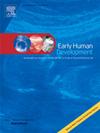Early pain findings in infants with brachial plexus birth injury: Relationship with function and comorbidities, and cut-off point for fractures
IF 2.2
3区 医学
Q2 OBSTETRICS & GYNECOLOGY
引用次数: 0
Abstract
Background
Infants with birth brachial plexus injury (BPBI) may have various comorbidities such as fractures, torticollis, plagiocephaly, central nervous system disorders. In infants with BPBI, it is important to identify fractures, which are common among comorbidities, objectively assess pain, and investigate factors that may be associated with pain.
Aim
The aim of this study is to determine the pain level, comorbidities, and motor function in infants with BPBI and to examine the relationship between these parameters. The second aim is to determine the cut-off value of the pain score that may be a sign of fracture in patients with BPBI, in order to suspect and predict a fracture in the shoulder region and to request additional examinations.
Subjects and measurements
59 infants with BPBI aged 15–90 days were included in the study. Comorbidities, active joint movements, and total upper extremity function assessed with the Active Movement Scale and pain scores measured with the FLACC Pain Scale were retrospectively analyzed. In addition, pain, comorbidities and motor function were investigated according to types of Narakas, which indicates the degree of nerve injury.
Results
Of the 59 participants, 18 (30.5 %) had at least one comorbidity and 12 (20.3 %) had fractures. The number of comorbidities (p = 0.41), the number of fractures (p = 0.84), and the level of pain (p = 0.71) did not differ by types of Narakas. There was a moderate negative correlation between pain level and upper extremity motor function in upper trunk injuries (p < 0.5, −0.67 < r < −0.46). There was a difference in pain level measured by palpation (p < 0.01) and passive joint movement (p < 0.01) in infants with and without comorbidities. To suspect a fracture in the shoulder region and to request further evaluation, the cut-off value of the Flacc pain level, which may predict a fracture, was 3.5 points for palpation and passive shoulder abduction and 4.5 points for passive external rotation.
Conclusion
This is the first study in the BPBI to measure pain in infants using a quantifiable and widely used assessment. Pain level was ranked from high to low as infants with fractures, infants with comorbidities other than fractures and infants without comorbidities. Increased pain adversely affects motor function and pain above the cut-off values is a predictor of fracture.
臂丛神经产伤婴儿的早期疼痛发现:与功能和合并症的关系,以及骨折的临界点。
背景:出生时臂丛神经损伤(BPBI)的婴儿可能合并多种疾病,如骨折、畸形、头畸形、中枢神经系统疾病等。对于患有臂丛神经损伤(BPBI)的婴儿,重要的是识别合并症中常见的骨折,客观评估疼痛,并调查可能与疼痛相关的因素。第二个目的是确定可作为 BPBI 患者骨折征兆的疼痛评分临界值,以便怀疑和预测肩部骨折并要求进行额外检查:59名患有BPBI的婴儿被纳入研究,年龄为15至90天。研究回顾性分析了合并症、主动关节运动、主动运动量表(Active Movement Scale)评估的上肢总功能以及FLACC疼痛量表(FLACC Pain Scale)测量的疼痛评分。此外,还根据表示神经损伤程度的纳拉卡斯类型对疼痛、合并症和运动功能进行了调查:59名参与者中,18人(30.5%)至少有一种合并症,12人(20.3%)有骨折。并发症数量(p = 0.41)、骨折数量(p = 0.84)和疼痛程度(p = 0.71)在 Narakas 类型上没有差异。在上肢躯干损伤中,疼痛程度与上肢运动功能呈中度负相关(p 结论:这是 BPBI 首次使用可量化且广泛使用的评估方法测量婴儿疼痛的研究。疼痛程度由高到低依次为骨折婴儿、合并骨折以外疾病的婴儿和无合并症的婴儿。疼痛加剧会对运动功能产生不利影响,而疼痛超过临界值则是骨折的预兆。
本文章由计算机程序翻译,如有差异,请以英文原文为准。
求助全文
约1分钟内获得全文
求助全文
来源期刊

Early human development
医学-妇产科学
CiteScore
4.40
自引率
4.00%
发文量
100
审稿时长
46 days
期刊介绍:
Established as an authoritative, highly cited voice on early human development, Early Human Development provides a unique opportunity for researchers and clinicians to bridge the communication gap between disciplines. Creating a forum for the productive exchange of ideas concerning early human growth and development, the journal publishes original research and clinical papers with particular emphasis on the continuum between fetal life and the perinatal period; aspects of postnatal growth influenced by early events; and the safeguarding of the quality of human survival.
The first comprehensive and interdisciplinary journal in this area of growing importance, Early Human Development offers pertinent contributions to the following subject areas:
Fetology; perinatology; pediatrics; growth and development; obstetrics; reproduction and fertility; epidemiology; behavioural sciences; nutrition and metabolism; teratology; neurology; brain biology; developmental psychology and screening.
 求助内容:
求助内容: 应助结果提醒方式:
应助结果提醒方式:


